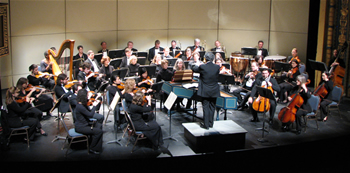Lorenzo Muti, music director of the Chamber Orchestra of the Triangle, is well-known for his passion for the music of Wolfgang Amadeus Mozart (1756-91). His final program for the orchestra’s 2010-11 season paired Mozart’s Requiem in D minor, K. 626 with the Requiem in C Minor (1804) of his rival in life and literature, Antonio Salieri (1750-1825). Muti chose the well-prepared Concert Singers of Cary, and fielded a nicely matched quartet of soloists consisting of soprano Jacquelyn Culpepper, mezzo-soprano Mary Gayle Greene, tenor Wade Henderson, and bass Don Milholin. All members of the quartet are well-known to Triangle music lovers from their many local choral and opera performances. The Cary choir was founded in 1991 and had been prepared by their cofounder and artistic director Lawrence Speakman. Muti preceded the concert with apt, extensive, and informal comments about the lives and works of the two composers given, as was the concert, in the main hall of the beautifully restored Carolina Theatre of Durham.
Salieri, who was born in Italy but centered his career in Vienna, was six years older than Mozart. He was accomplished at the court intrigue necessary for a successful profession and was skilled at orchestrating in the prevailing classical style. However, Salieri’s craftsmanship was not matched by an ability to compose a memorable melody. Salieri’s Requiem was composed for his own funeral but he lived some 16 years past its composition, a time fallow of musical creations and ending in madness. Throughout his requiem, the quartet of soloists never are used as individual soloists and the orchestral score serves to support choral and vocal lines, not as another “voice or singer” like Mozart does so often. I found the “Sequenz and Offertorium” harder to follow than usual, despite the clear diction of the choir and soloists. Extensive use is made of a leitmotif for English horn beginning in the dark opening bars and recurring throughout the work. This was well-played by Carrie Shull. Despite dramatic flourishes, the over-all mood of the Requiem is simple and elegiac. There is a lovely unaccompanied passage for the solo quartet and chorus with no strings. There is a startling change of key when the “Osanna” fugue returns. The “Libera me” is accompanied by winds only. Muti, his orchestra, chorus, and quartet of vocalists made the best possible case for Salieri but craftsmanship lingers over memorable melodies after the performance.
Muti used the original F. X. Sussmayr completion of Mozart’s Requiem but used a clarinet instead of the composer’s original basset horn. He recounted the shady origins of the work, commissioned covertly by Count Franz Walsegg-Stuppach who liked to have works of other composers performed as if he had composed them. Muti also explained the origins of the myth that Salieri supposedly poisoned Mozart, best known from Pushkin’s novella Mozart and Salieri and the Broadway play Amadeus.
Mozart’s originality was striking in every melodic line of his Requiem, with individual solos given to each of the quartet members and conspicuous independent melodies given to the orchestra, along with those written for the chorus. Muti’s orchestra conjured up the melancholy, prayerful opening with the clarinets and bassoons, supported by somber strings. The Concert Singers of Cary sang with admirable clarity whether in the slow opening or fast passages such as the vigorous, fugal “Kyrie elesion” or fiery “Dies irae.” Both soprano Jacquelyn Culpepper and mezzo-soprano Mary Gale Greene sang with winning clarity, warmth, and evenness of tone. Bass Don Milholin brought a firm, sepulchral bottom to his aria within “Tuba mirum” superbly accompanied by the lyrical solo trombone of Sean Devlin. Wade Henderson’s bright tenor provided strong contrast in the following “Mors stupebit.” The Cary choir delivered the concluding Handelian-like fugue stirringly.











